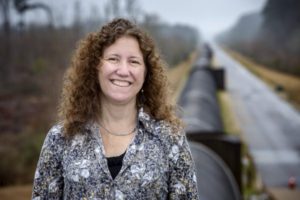Gabriela González, the spokesperson for the science collaboration that detected gravitational waves in spacetime passing over Earth for the first time this year, will deliver the ninth annual Robert M. Walker Distinguished Lecture at 7 p.m. Thursday, Nov. 17.
The talk, hosted by the McDonnell Center for the Space Sciences, will take place in Whitaker Hall, Room 100, on the Danforth Campus of Washington University in St. Louis. It is free and open to the public.

González is a professor in the department of physics and astronomy at Louisiana State University, where a large group of scientists works on the detection of gravitational waves. The university is only 30 miles away from the Laser Interferometer Gravitational-Wave Observatory (LIGO) Livingston Lab, one of two U.S. gravitational wave detectors funded by the National Science Foundation (NSF). The other is in Hanford, Wash.
González, who was born in Cordoba, Argentina, obtained her PhD from Syracuse University in 1995. She became a member of the LIGO Scientific Collaboration in 1997 and was elected its spokesperson 2011. She is featured in the documentary about gravitational waves produced by the LIGO Collaboration and the NSF, Einstein’s Messengers.
Albert Einstein’s theory of general relativity meant that gravitational waves should exist, but he doubted they would ever be detected because they alternately stretch and compress the fabric of spacetime by such tiny amounts.
This is why it was such big news when, on Sept. 14, 2015, two LIGO detectors in Hanford and Livingston registered a strong gravitational wave signal. The waves were created by the merger of two black holes, one about 29 times the mass of the sun and the other about 36 times its mass, 1.3 billion years ago, before there was even multi-cellular life on Earth.
In this violent cataclysm, three suns’ worth of mass was transformed into energy over a period of two-hundredths of a second, and it was this release of energy that shook the fabric of spacetime.
González in her lecture will describe: the detection of this distant cataclysm, the elegant instruments that were able to measure changes in distance a thousandth the diameter of a proton, and the window on the universe offered by the new field of gravitational-wave astronomy.
The lecture is sponsored by the McDonnell Center for Space Sciences in memory of Robert M. Walker, PhD, the center’s inaugural director from 1975 to 1999.
Walker was a pioneering physicist who shaped research in the space sciences worldwide. The Walker lecture series was established in 2008 by Ramanath Cowsik, the James S. McDonnell Professor of Space Sciences and director of the McDonnell Center.
The McDonnell Center, established in 1975 through a gift from aerospace pioneer James S. McDonnell, is a consortium of Washington University faculty, research staff and students primarily from the departments of Earth and Planetary Sciences and Physics, both in Arts & Sciences, who are working on the cutting edge of space research.
Questions? Please contact Jan Foster at: janf@wustl.edu
